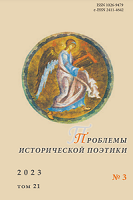Формирование хронотопа в «Дневнике Писателя» Достоевского 1873 г. (главы «Вступление», «Старые люди»)
Formation of the Chronotope in the “A Writer’s Diary” by Dostoevsky in 1873 (Chapters “Introduction”, “Old People”)
Author(s): Daria D. BuchnevaSubject(s): Russian Literature, Philosophy of Language, 19th Century, Theory of Literature, Sociology of Literature
Published by: Петрозаводский государственный университет
Keywords: Dostoevsky; A Writer’s Diary; Grazhdanin; The Citizen weekly; chronotope; Bakhtin; Ukhtomsky; time; space;
Summary/Abstract: The “chronotope” category introduced into literary criticism by M. M. Bakhtin is one of the most studied in recent times. It is believed that he is considered the founder of the term, but the authorship of the concept belongs to A. A. Ukhtomsky, who used it when developing the doctrine of the dominant at the beginning of the 20th century. Thanks to the works of Bakhtin, “chrono- tope” has become a common term. For the first time publications about the poetics of the chronotope in the works of Russian and foreign literature appeared in the 1980s–90s. Especially significant is the study of the chronotope as a category of ethnopoetics. Works in which the chronotope is presented as an image of the national picture of the world have been published the late 1980s. Bakhtin’s research on Dostoevsky’s poetics opened up new frontiers for studying the writer’s works from the viewpoint of spatio-temporal structure. In “A Writer’s Diary” of 1873, a complex chronotopic hierarchy appears. So, the first chapters contain conditionally real and fantasy chronotopes, which, in turn, entail more local ones: Chinese, Herzenian, symbolic, St. Petersburg, etc. Dostoevsky cre- ates an artistic chronotope that exists in the space of utterance, of speech. The chronotope of “A Writer’s Diary” differs from real time-space. They are not identical. The poetics of the chronotope is complicated by the fact that the “Diary” is part of a time-based publication. In (“Grazhdanin”) “The Citizen,” Dostoevsky’s column was the ideological core of the weekly. Thematically, not only the chapters of “A Writer’s Diary” but also all the articles in the issue were connected, so Dostoevsky needed to conceptually stipulate the subject of the rubric and the issue as a whole.
Journal: Проблемы исторической поэтики
- Issue Year: 21/2023
- Issue No: 3
- Page Range: 62-79
- Page Count: 18
- Language: Russian

